Lincoln’s trails are for everyone: with exceptions. A guest post by Kathryn Kelly.
Like many folks, I’ve enjoyed bicycles since I was a kid, and they evolved to meet my needs over the years. From trike to stingray to ten-speed, hybrid to mountain bike, commuter setup to gravel bike. Adaptations such as tire size and tread, fixed vs. suspension forks, and fenders and racks vs. minimal weight goals allowed me to use bicycles in different ways: touring, commuting to school and work, off-road MTB rides, and exploring gravel roads. As an adult, most miles have been logged on Lincoln’s terrific trail network.
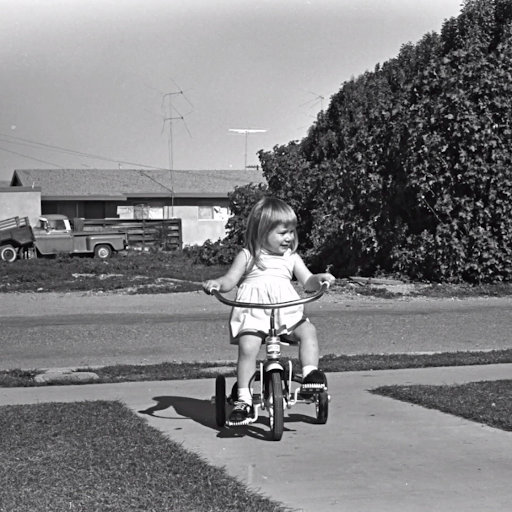
My first bike, circa 1960.
Our shared trails are well-loved and well-used, thanks to a mutual respect for others. You’ll see recreational and competitive cyclists. Bike commuters and pedaling kids following parents like ducklings. Roller blades and wheelchairs. Runners, dog walkers, adults pushing strollers, friends chatting side-by-side, and nature lovers — all enjoying the variety of landscapes linked by our trails.
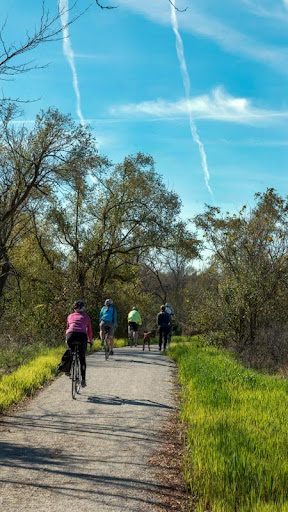
https://www.lincoln.ne.gov/City/Departments/Parks-and-Recreation/Parks-Facilities/Trails
So, what’s allowed on our shared-use trails?
If you’re like me, you may feel confused about some of the vehicles seen on our trails, especially those that are motor powered. What exactly is permitted on our shared-use paths? The following ordinances are referenced from the Lincoln Municipal Code, with pertinent information highlighted.
10.02.335 Shared-Use Path. Shared-Use Path shall mean a path or trail physically separated from motorized vehicular traffic by an open space or barrier, either within the roadway right-of-way or within an independent right-of-way, designed to serve travelers such as pedestrians, bicyclists, skaters, skateboarders, wheelchair users, and users of electric personal assistive mobility device but not open to vehicles such as cars, trucks, minibikes, motorcycles, or all terrain vehicles. (Ord. 20395 §3; December 12, 2016).
As e-bikes have become more popular, the variety of electric powered two-wheel (and 3-wheel) vehicles has increased. E-bikes have made transportation and errands more accessible, and you’ll see cargo bikes, extended frames that have seating for children, and commuter setups powered with electric motors. People with fitness or physical limitations can once again enjoy bicycling and get a workout with pedal assistance. And models with more powerful electric motors help mountain bikers climb steep trails and enjoy more down hill runs. But you may have spotted some questionable two-wheel vehicles on our trails that are powered by motors.
The city has defined bicycles to include e-bikes:
10.02.050 Bicycle. Bicycle shall mean: (a) a device propelled solely by human power, upon which any person may ride, and having two or three wheels, at least one of which is more than fourteen inches in diameter; or (b) a device with two or three wheels, fully operative pedals for propulsion by human power, and an electric motor with a capacity not exceeding seven hundred fifty watts which produces no more than one brake horsepower and is capable of propelling the bicycle at a maximum designed speed of no more than twenty miles per hour on level ground. (Ord. 20395 §1; December 12, 2016).
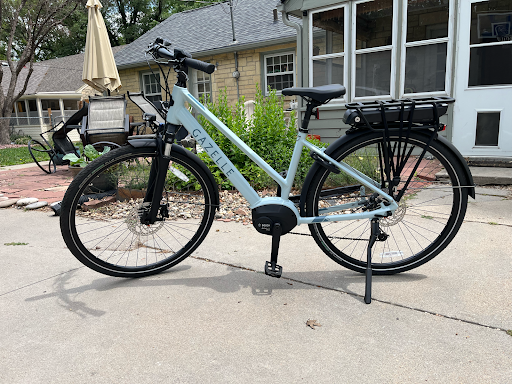
My first e-bike, Class 1 pedal assist Gazelle with a 750-watt motor and max speed of 20 mph.
But more and more often, we encounter motorized vehicles on the trails that blur the line between bikes and mopeds, dirt bikes, and motorcycles. Unfortunately, we’ve also crossed paths with some riders who are inconsiderate and reckless.
Which vehicles are PROHIBITED on our multi-use trails?
This 1,000 watt, 26.1 mph e-bike is NOT legal on Lincoln trails.
12.08.025 Operation on Trails Prohibited. It shall be unlawful for any person to operate any moped, golf cart, motor vehicle, motorcycles, tractors, off-road vehicles, go carts, riding lawnmowers, garden tractors, all-terrain vehicles, snowmobiles, and any gas-powered bicycle upon any multi-use trails or hiker-biker trails in the city, except those operated by City employees, those authorized by City, and riding lawn mowers mowing abutting property. (Ord. 21610 §2; June 03, 2024).
Electric scooters are also prohibited from hiker-biker and multi-use trails, as per
10.49.010 Electric Foot Scooter Operation Violation. Every person operating an electric foot scooter shall abide by the provisions established for bicycle riders as set forth in Chapter 10.48 of the Lincoln Municipal Code except those found in Sections 10.48.250 and 10.48.260. It shall also be unlawful to operate an electric foot scooter on any hiker-biker or multi-use trail as defined in Section 12.08.010 or Shared-Use Path as defined in Section 10.02.335 and it shall be unlawful to operate an electric foot scooter on sidewalks along Canopy Street and Pinnacle Arena Drive.(Ord. 21239 §4; March 21, 2022).
And the there are speed limits on our trails:
12.08.060 Speed Limit in Parks. It shall be unlawful for any person to drive, operate, or propel over or along any park roadway, hiker-biker trail, or the multi-use trails any vehicle, motor vehicle, moped, bicycle, or tricycle, or to drive or ride any horse or other animal at a greater speed than twenty-five miles per hour. The Director may authorize regulations requiring a speed lower than twenty-five miles per hour on any park roadway, hiker-biker trail, or the multi-use trails or segment thereof. Such regulations shall be approved by the Mayor and filed with the office of the City Clerk. Such lower speed limits shall be posted along the portion so regulated, and upon such posting shall be in full force and effect. (Ord. 19819 §4; December 17, 2012
It’s important to note that although the city allows speeds of up to 25 mph on trails, when approaching and passing pedestrians, dogs on leash, small children, and slower riders, cyclists must reduce their speed and announce their passing to ensure everyone’s safety. Pedestrians have the right of way.
The need for improved education, public information, and signage
It’s unlikely to expect that all trail users would take the time to navigate and search the Lincoln Municipal Code to make sure they’re compliant. How can we make this information widely visible and clear to trail users?
Many municipalities across the country and internationally are promoting responsible shared trail use by publicizing and posting information on the different types of electric vehicles permitted. They vary; some have age limits and helmet requirements. Generally, most municipalities permit bicycles with functional pedals, electric motors 750 watts max and pedal assist speed max of 20 mph. That includes Class 1 and Class 2 e-bikes. Class 3 e-bikes which can reach speeds of 28 mph are not permitted, nor are other electric vehicles.
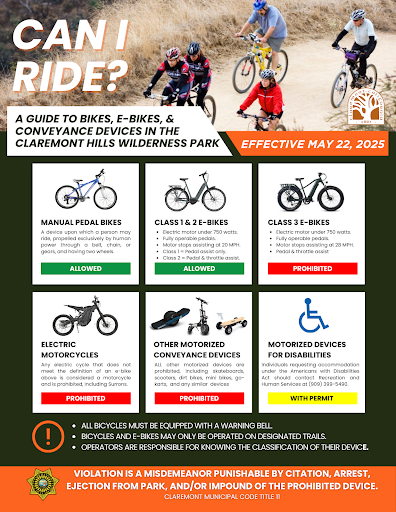
Example from the City of Claremont, CA: https://www.claremontca.gov/News-articles/E-Bike-Use-at-CHWP
This chart clearly shows electric bicycles categories and regulations.
From Carlsbad, CA: https://www.carlsbadca.gov/departments/streets-traffic/traffic-safety/electric-bikes
I’m glad to learn that Lincoln Parks & Recreation is currently exploring how to best educate trail users on the rules, restrictions, and etiquette that apply to our city shared trails. The more we can promote this information at trailheads and to those purchasing e-bikes and other electric motor vehicles, we can hopefully reduce the number of prohibited vehicles and unsafe usage. Clear signage may reduce the number of riders who are unknowingly using trails on prohibited vehicles.
We recently visited Vancouver and Seattle, two cities with extensive bike lane and trail systems. The following is Seattle proposed signage as they studied and piloted expanded used of e-bikes on their multi-use trails.
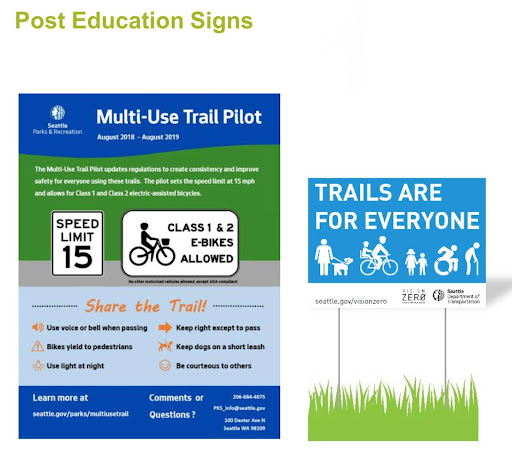
https://www.seattle.gov/documents/Departments/ParksAndRecreation/BriefingPapers/Multi-use%20trail%20pilot%20briefing%20paper%20and%20attachments.pdf
Trail signage in Scotland encourages reporting of illegal bikers.
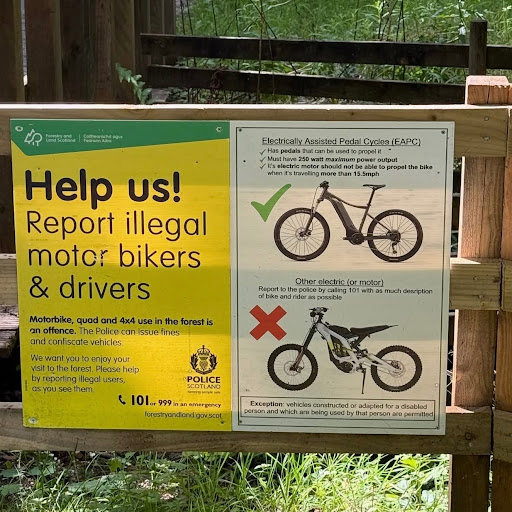
Photo courtesy of Susan Larson Rodenburg.
E-bikes are not the enemy. I began to consider a pedal assisted e-bike as an option to continue riding without some of the discouragement I felt when I reached my mid-60s and faced joint issues. Today, my primary bike is a Class 1 drop bar, gravel bike with a 400-watt electric motor and max assisted speed of 20 mph. The aluminum frame is light enough that I don’t need to use pedal assist power for most of the ride, but it’s available when climbs, wind, or distance begin to slow me down. It’s perfect for gravel rides and in-town transportation. The added power isn’t used to increase my speed, but to maintain cadence or keep up with my faster friends. You know who you are 😉.
I’m no longer ashamed of being an e-bike cyclist. The option to continue to challenge myself while experiencing the joy of riding? It’s powerful!
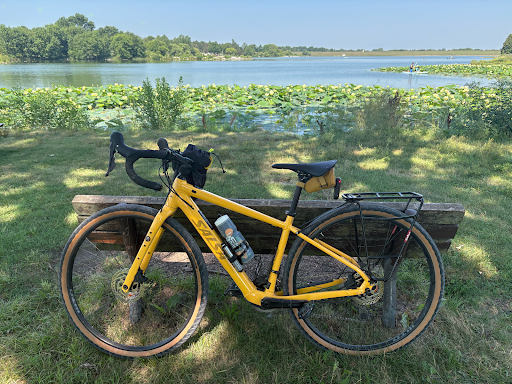
My current Salsa Confluence e-bike.
What are your thoughts on how to best educate trail users with signage and promotion of regulations?
Kathryn Kelley (retired librarian, current Lincoln Bike Kitchen volunteer)

Nice job, Kathy. Thoroughly done! Let’s start referring to the e-bikes that look like motorcycles as “e-motorcycles” to help folks differentiate between what aunt Agnes is riding to Open Harvest, and what Jimmy is using to tear up Wilderness Park. Without enforcement-fines and impounding vehicles-reckless trail behavior will be tough to combat. For now, if you see trouble, call LPD with a solid description of the rider, place and time.
Thank you Kathryn and Janine for posting this! We need to be proactive before someone gets killed. Some have already been hurt.